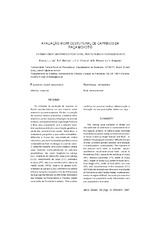Mostrar el registro sencillo del ítem
Avaliação morfoestutural de caprinos da raça moxotóBenício
| dc.contributor.author | Rocha, L.L. da | es_ES |
| dc.contributor.author | Oliveira, J.C.V. | es_ES |
| dc.contributor.author | Benício, R.C. | es_ES |
| dc.contributor.author | Ribeiro, M.N. | es_ES |
| dc.contributor.author | Delgado-Bermejo, J.V. | |
| dc.date.accessioned | 2010-04-09T08:18:31Z | |
| dc.date.available | 2010-04-09T08:18:31Z | |
| dc.date.issued | 2007 | |
| dc.identifier.issn | 1885-4494 | |
| dc.identifier.uri | http://hdl.handle.net/10396/2890 | |
| dc.description.abstract | The raising goat systems in Brazil are characterized as extensive or semi-extensive in the majority of them. In native breeds dominate the extensive system, being common introduction of exotic breed as Anglo Nubian and Boer. In addition, the geographic isolation difficulty change of sires, promote genetic isolation and changes in breed pattern, consequently. The objective of the present work were to evaluate eleven quantitative morphoestructural traits: raised to the withers (RW), raised to the entrance of croup (RC), thoracic perimeter (PT), width of croup (WC), length of croup (LC), width of head (WH), face length (FL), width of face (WF), ear size (ES), shin circumference of the cinnamon (CCi) of 313 Moxoto animal breed of several municipality of Pernambuco and Paraíba States, northeastern, semi arid region of Brazil. According to canonical analyses it is possible to verify diferentiation and sub populations formation. | en |
| dc.description.abstract | Os sistemas de produção de caprinos no Brasil caracterizam-se na sua maioria como extensivo ou semi-extensivo. Porém, na criação de caprinos nativos predomina o sistema ultra-extensivo, sendo comum a introdução de animais exóticos, principalmente das raças Anglo Nubiana e Boer para cruzamento com o rebanho local, fato que tem contribuído para diluição genética e perda das características raciais.. Além disso, o isolamento geográfico a que estão submetidos, dificulta a troca de reprodutores entre rebanhos, promove isolamento genético e como conseqüência final, mudanças no padrão racial. O presente trabalho teve como objetivo utilizar onze variáveis morfo-estruturais de natureza quantitativas, tais como: longitude da cabeça (LC); longitude do rosto (LR); largura da cabeça (LCa); comprimento do corpo (CC); perímetro torácico (PT); altura da cernelha (AC); altura da região sacral (ARS); largura da garupa (LG); longitude da garupa (LGa); perímetro da canela (PCa) e; tamanho da orelha (TO) de 313 animais da raça caprina Moxotó, de diferentes municípios dos Estados de Pernambuco e Paraíba, região semi-árida do Nordeste brasileiro. Pela análise canônica foi possível verificar diferenciação e formação de sub-populações dentro da raça. | es_ES |
| dc.format.mimetype | application/pdf | es_ES |
| dc.language.iso | por | es_ES |
| dc.publisher | Universidad de Córdoba, Servicio de Publicaciones | es_ES |
| dc.rights | https://creativecommons.org/licenses/by-nc-nd/4.0/ | es_ES |
| dc.source | Archivos de zootecnia 56 (Suplemento 1), 483-488 (2007) | es_ES |
| dc.subject | Medidas corporais | es_ES |
| dc.subject | Cabras | es_ES |
| dc.title | Avaliação morfoestutural de caprinos da raça moxotóBenício | es_ES |
| dc.title.alternative | Estimation of morphoestructural traits in moxoto breed goats | en |
| dc.type | info:eu-repo/semantics/article | es_ES |
| dc.relation.publisherversion | http://www.uco.es/organiza/servicios/publica/az/az.htm | es_ES |
| dc.rights.accessRights | info:eu-repo/semantics/openAccess | es_ES |

